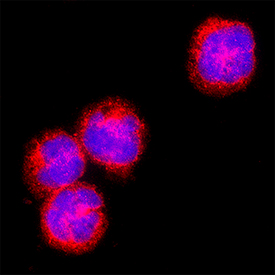Human Notch-1 Intracellular Domain Antibody Summary
Gly2428-Lys2556
Accession # AAG33848
Applications
Please Note: Optimal dilutions should be determined by each laboratory for each application. General Protocols are available in the Technical Information section on our website.
Scientific Data
 View Larger
View Larger
Notch‑1 in MOLT‑4 Human Cell Line. Notch‑1 was detected in immersion fixed MOLT‑4 human acute lymphoblastic leukemia cell line using Mouse Anti-Human Notch‑1 Intracellular Domain Monoclonal Antibody (Catalog # MAB3647) at 8 µg/mL for 3 hours at room temperature. Cells were stained using the NorthernLights™ 557-conjugated Anti-Mouse IgG Secondary Antibody (red; NL007) and counterstained with DAPI (blue). Specific staining was localized to cell surface and cell nuclei. Staining was performed using our protocol for Fluorescent ICC Staining of Non-adherent Cells.
Reconstitution Calculator
Preparation and Storage
- 12 months from date of receipt, -20 to -70 °C as supplied.
- 1 month, 2 to 8 °C under sterile conditions after reconstitution.
- 6 months, -20 to -70 °C under sterile conditions after reconstitution.
Background: Notch-1
Human Notch-1 is a 300 kDa type I transmembrane glycoprotein that is one of four human Notch homologues involved in developmental processes (1-3). Notch signaling is important for maintaining stem cells and inducing differentiation, especially in the nervous system and lymphoid tissues (2-4). Notch can specify binary cell fates; for example, promoting T- over B-cell development from a common precursor (2). More than 50% of human T-lineage acute lymphoblastic leukemia (T‑ALL) have activating mutations of Notch1 (1, 5). Human Notch-1 is synthesized as a 2556 amino acid (aa) precursor that contains an 18 aa signal sequence, a 1718 aa extracellular domain (ECD) with 36 EGF-like repeats and three Lin-12/Notch repeats (LNR), a 23 aa transmembrane (TM) segment and a 785 aa cytoplasmic domain containing six ankyrin repeats, a glutamine-rich domain and a PEST sequence. The 11th and 12th EGF-like repeats bind ligands including Jagged and Delta-like families in humans (6). O-fucosylation by Fringe family members at a site within this region can inhibit the interaction of Notch with Jagged ligands, thereby promoting Delta-like ligand interactions (7). Notch-1 receptor undergoes post-translational furin-type proteolytic cleavage, forming a heterodimer through interaction of a hydrophobic area C-terminal to the LNR on the 1647 aa ligand-binding extracellular region with the 891 aa transmembrane/cytoplasmic portion (8, 9). Upon ligand binding, additional sequential proteolysis by TNF-converting enzyme (ADAM17) and the presenilin-dependent gamma -secretase results in the release of the Notch intracellular domain (NICD) which translocates into the nucleus, activating transcription of Notch-responsive genes (10). Human Notch-1 ECD aa 19-526, including the first 13 EGF repeats, shows 91% aa identity with corresponding regions of mouse and rat, 89% with canine, and 79% with chicken Notch-1. This region also exhibits 60% aa identity with human Notch-2 and Notch-3.
- Ellisen, L.W. et al. (1991) Cell 66:649.
- Dumortier, A. et al. (2005) Int. J. Hematol. 82:277.
- Yoon, K. and N. Gaiano (2005) Nat. Neurosci. 8:709.
- Androutsellis-Theotokis, A. et al. (2006) Nature 442:823.
- Weng, A.P. et al. (2004) Science 306:269.
- Hambleton, S. et al. (2004) Structure 12:2173.
- Yang, L. et al. (2005) Mol. Biol. Cell 16:927.
- Sanchez-Irizarry, C. et al. (2004) Mol. Cell. Biol. 24:9265.
- Logeat, F. et al. (1998) Proc. Natl. Acad. Sci. USA 95:8108.
- Mumm, J.S. and R. Kopan (2000) Dev. Biol. 228:151.
Product Datasheets
FAQs
No product specific FAQs exist for this product, however you may
View all Antibody FAQsReviews for Human Notch-1 Intracellular Domain Antibody
There are currently no reviews for this product. Be the first to review Human Notch-1 Intracellular Domain Antibody and earn rewards!
Have you used Human Notch-1 Intracellular Domain Antibody?
Submit a review and receive an Amazon gift card.
$25/€18/£15/$25CAN/¥75 Yuan/¥2500 Yen for a review with an image
$10/€7/£6/$10 CAD/¥70 Yuan/¥1110 Yen for a review without an image






